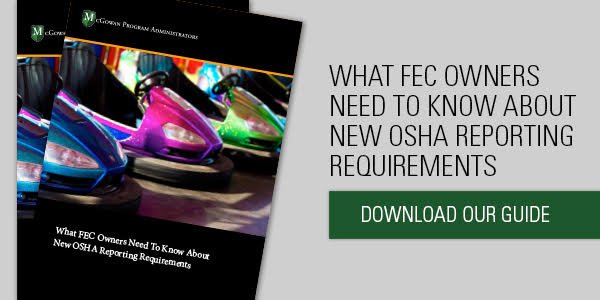Limiting risk helps everybody in the family entertainment center (FEC) community. Customers and workers stay healthy and keep coming back. Owners and managers make profit targets and grow the business. The longer you avoid mishaps and lawsuits, the stronger your reputation becomes.
Doing only the obvious — following safety protocols and obeying the laws enforcing them — is not enough. To meaningfully reduce risk, you need to take an in-depth look at the nuances of your FEC that influence your risk exposures.
Here are seven tips for reducing or limiting risk in your FEC:
1. Prove that you take safety seriously.
A lot of McGowan clients wonder how to lower their premiums or widen their coverage. Like all insurers, we take objective facts to our underwriters and they decide the likelihood that your business will generate a claim.
These are the kinds of facts they like to see:
- Proof that you’ve conducted in-depth safety training for your staff and customers
- Complete pre-inspection checklists and logs
- Comprehensive maintenance records
- Certifications like PA, AIMS, NAARSO, etc.
You should also use trained operators whenever possible (one operator per attraction is the recognized industry standard, but more is better if you have the resources). And you should build safety and professionalism into every business process.
Don’t think of “best practices” as tired business jargon. Consider them a challenge to continuously make your FEC safer.
2. Get your paperwork in order.
Making good use of Hold-Harmless and Indemnification Waivers can ward off frivolous lawsuits. Also, avoid agreeing to indemnification language in your contracts with other businesses whenever possible…we don’t want to assume the liabilities of other, unless it is absolutely necessary.
It’s crucial to make sure customers sign these documents. If they don’t, you have no contract, and therefore no legal protection. Also, have customers sign off on rules and operating instructions.
3. Stay inside the boundaries.
Rules, guidelines, and standards are there for a reason. Make a point of always following manufacturers’ recommendations for ages, number of riders, weights, and allowed activities.
Make regular use of instructional videos, rule signs, and other operational safety tools. Make sure your managers understand OSHA guidelines and are trained to uphold them.
Be aware of ASTM standards for your industry segment and attractions and make sure you are adhering to them as a part of your corporate commitment to safety.
4. Hire reputable subcontractors.
Your vendors are an extension of your business, so they need to reflect your values. Be sure to establish a contractual relationship with your subcontractors and insist that they provide proof of insurance. Preferably, they should name you as an additional insured.
Take the time to understand how they operate, train staff, and maintain their equipment. Monitor their activities and make sure everything they do lives up to your standards.
5. Scrutinize your inventory.
Sit down with your insurance broker and talk over every attraction in your FEC. Make sure both of you understand which elements cost the most to insure, and why those costs are higher. That makes it easier to decide if the risk exposure is worth it.
If, for example, you have 14 attractions and two of them give your insurer some extra measure of concern, you’ll need to measure the insurance savings against the revenue each unit generates. There may be a few places where you’re exposing yourself to extra liability without a revenue boost.
6. Take the initiative to mitigate claims.
There’d be no such thing as insurance if it were possible to eliminate risk. Accidents happen. People make mistakes. Damage triggers litigation.
As any lawyer will tell you, it’s always prudent to do all you can to prove in court that you take safety seriously. That makes it much tougher to prove negligence and impose punitive damages.
Here are a few things you can do to mitigate a damage claim:
- Establish a protocol for dealing with accidents, and train everybody to use the protocol.
- Develop an incident-reporting process.
- Document and complete a claim file with the following:
- Completely and accurately fill out an incident report
- Gather photographic or video evidence
- Witness forms
- Schematic details of the incident
- Participant statements
- Copies of signed waivers and customer contracts
- Insurance brokers’ contact information
7. Talk to your broker.
Don’t assume your broker knows the FEC business as well as you do. When you’re discussing insurance with brokers, it’s okay to challenge them and make sure they truly understand the subtleties of your FEC.
Make sure you know your options before entering talks with a broker. Showing you’ve taken the time to learn the many coverages available to you is a great way to build trust and strengthen your relationship.
When you and your broker are on the same side of things, they may be able to win over the underwriters and secure the coverage you need that fits your budget.
A strong partner for FEC risk controls
At McGowan Program Administrators, we’ve worked hard to develop Family Entertainment Center Insurance that keeps the fun flowing while provisioning for the inevitable mishaps that create liability risks. Our experts can clear up your questions about controlling your risks and finding the ideal coverage for your unique business.
Related articles:
How to Properly Use Extension Cords to Prevent Injury and Property Damage
Why the Top FECs Consistently Outperform Their Peers in Safety
Social Media: What You Say Can Hurt You
4 Questions You Should Ask About Family Entertainment Center Risk Management



